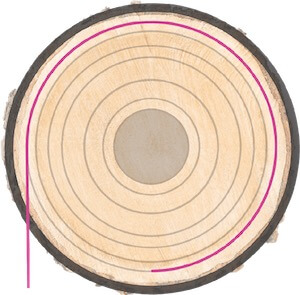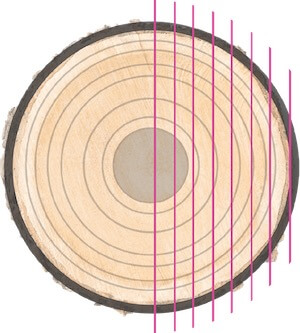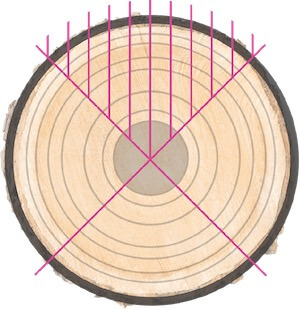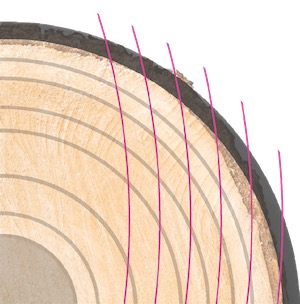
Rotary Cut

Rotary Cut veneer is produced by rotating a log while shaving a full-length continuous sheet.
This process is the only cutting method that produces whole-piece face veneers.
A Rotary Cut will yield veneer with a broad grain pattern with no plain sliced or quartered appearance.
Rotary cut veneers are used in the majority of panels produced in North America.
This process yields the most veneer per log and is usually less expensive than sliced veneer.

Plain Sliced

Plain slicing occurs when a log is only turned a few inches at a time when slicing it, versus a constant turn and peeling method used for Rotary Cut veneer.
Plain Sliced veneer produces a cathedral grain pattern, similar to the pattern produced when plain sawn lumber is produced.
Plain Sliced veneer is cut along the growth rings, producing the highest yield of any “slicing” method.

Quarter Sliced

Quarter Slicing is the method of slicing the veneer perpendicular to the growth rings.
This method produces a straight grain appearance, similar to Rift Sliced.
Quarter Slicing of an Oak species will produce a flake pattern while in other species it will only produce a straight grain or stripes.
Since all cuts are perpendicular to the growth rings, Quarter Slicing produces narrow veneer flitches and yields less veneer than the Plain Sliced method.

Rift Cut

Rift Cutting is the process of slicing the veneer at a 15-degree angle to the radius of the log to produce a straight, striped grain appearance without the flakes that appear in Quarter Sliced veneer.
Red and White Oak are generally the species that are Rift sawn to avoid the flakey appearance.
The Rift Cut method yields the least amount of veneer than any other method and is, therefore, the most expensive. This process also yields narrow flitches of veneer similar in size to those produced by Quarter Slicing.
